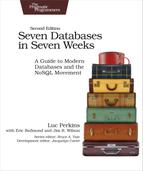Hu(mongo)us
Mongo hits a sweet spot between the powerful queryability of a relational database and the distributed nature of other databases, like HBase. Project founder Dwight Merriman has said that MongoDB is the database he wishes he’d had at DoubleClick, where as the CTO he had to house large-scale data while still being able to satisfy ad hoc queries.
Mongo is a JSON document database (though technically data is stored in a binary form of JSON known as BSON). A Mongo document can be likened to a relational table row without a schema, whose values can nest to an arbitrary depth. To get an idea of what a JSON document is, check this out:

In some ways, document databases have an opposite workflow compared to relational databases. Relational databases such as PostgreSQL assume you know what data you wish to store without necessarily knowing how you want to use it; what’s important is how you store it. The cost of query flexibility is paid upfront on storage. Document databases require you to make some assumptions on how you wish to use your data, but few assumptions on what exactly you wish to store. You can make fundamental “schema” changes on-the-fly, but you may have to pay for your design decisions later on.
Mongo is an excellent choice for an ever-growing class of web projects with large-scale data storage requirements but very little budget to buy big-iron hardware. Thanks to its lack of structured schema, Mongo can grow and change along with your data model. If you’re in a web startup with dreams of enormity or are already large with the need to scale servers horizontally, consider MongoDB.

I was on the fence about using a document database until I actually spent time on teams using document stores in production. Coming from the relational database world, I found Mongo to be an easy transition with its ad hoc queries, and its ability to scale out mirrored my own web-scale dreams in ways that many relational stores couldn’t. But beyond the structure, I trusted Mongo’s development team. They readily admitted that Mongo wasn’t perfect, but their clear plans (and general adherence to those plans) were based on general web infrastructure use cases, rather than idyllic debates on scalability and replication. This pragmatic focus on usability should shine as you use MongoDB. A trade-off of this evolutionary behavior is that there are several paths to performing any given function in Mongo.
